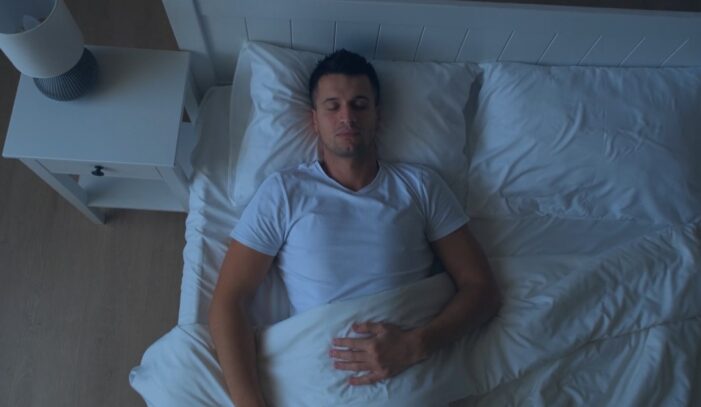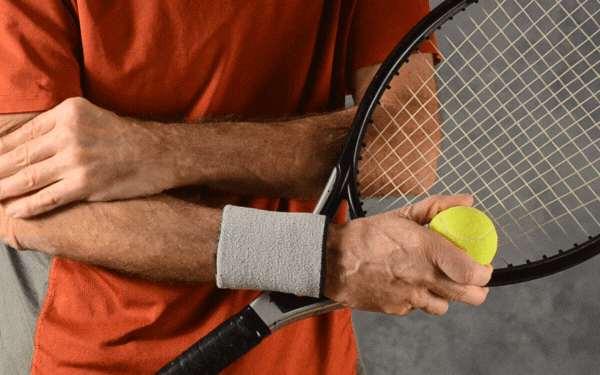Tennis elbow, also known as lateral epicondylitis, is a condition that causes pain and discomfort in the elbow and forearm. It is a common injury among tennis players and individuals who engage in repetitive motions with their arms. Sleeping with tennis elbow can be a challenge, as it can be difficult to find a comfortable position that does not aggravate the condition.
However, with the right techniques and tools, it is possible to sleep comfortably and reduce the pain associated with tennis elbow. In this guide, we will explore the best sleeping positions and strategies for individuals with tennis elbow, as well as tips for pain management and prevention.
Whether you are a tennis player recovering from an injury or an individual struggling with chronic tennis elbow pain, this guide will provide you with the information you need to get a good night’s sleep and manage your symptoms.
Identify the Symptoms
Tennis elbow is a condition that causes pain and tenderness around the outside of your elbow and can make sleeping uncomfortable. To understand if you have tennis elbow and how best to treat it, it’s important to identify the symptoms.
This includes pain and tenderness around the outside of the elbow, difficulty extending the wrist, and a weakened grip.
It’s also important to note that the pain can be worse when exercising or gripping something, or even when in a certain position for a long period of time.
Understand the causes of tennis elbow

It’s caused by repetitive motions of the wrist and arm, usually when playing racquet sports like tennis or squash. The repeated strain on the forearm muscles and tendons can lead to tiny tears in the tissue, causing irritation and pain. While it’s possible to get tennis elbow without playing a racquet sport, it’s rare — most cases are due to overuse injuries sustained while playing.
The most common symptom of tennis elbow is pain near the outer or inner side of the elbow, particularly when moving your wrist or attempting to grip something with your fingers. The pain may also be felt in your forearm down towards your wrist. Other signs include:
- Weakness in your hands
- A burning sensation in your elbow joint
- Swelling around your affected area
- Limited range of motion in your arm or wrist
- Pain that radiates up into your shoulder or down into your fingertips
Recognize the signs of tennis elbow
It typically affects men and women between the ages of 30-50. It can be caused by activities that involve repetitive motions of the wrist and arm such as tennis playing or other racquet sports, painting/wallpapering, playing golf, or other activities that require repeated gripping or reaching motions.
Symptoms of tennis elbow include:
- Pain or tenderness on the outside of your elbow
- Pain can range from a mild dull ache to a sharp burning sensation
- Pain may spread down to your wrist or up into your biceps
- Pain may worsen when doing everyday activities such as gripping objects, lifting, turning doorknobs, or shaking hands
- The area around your outer elbow may be swollen and tender when touched
If you experience any of these symptoms, it’s best to see your doctor for an accurate diagnosis. If you suspect that you have tennis elbow, take steps to avoid further injury while strengthening your arm muscles with exercises designed specifically for this condition. To help reduce pain associated with this disorder, rest your arm as much as possible when not using it, and try using an ice pack for 15 minutes at a time several times a day.
Treat the Pain

Sleeping with tennis elbow can be very difficult because of the pain in the elbow, wrist, and forearm area.
However, it is possible to get a better night’s sleep by taking some steps to treat the pain associated with the tennis elbow.
We will go over the different treatments and tips that can help you get a better night’s sleep with tennis elbow.
Use cold and heat therapy
One of the main strategies for treating tennis elbow is to alternate between cold and heat therapy. Cold therapy helps to reduce pain and swelling associated with tennis elbow. Applying an ice pack directly to the affected area can help reduce inflammation, decrease pain, and improve the range of motion. Heat therapy, on the other hand, can help further relax the muscles and stimulate circulation in the affected area resulting in increased strength.
It is important to use caution when administering cold or heat therapy as they may cause discomfort or even permanent damage if not done correctly. For example, never apply hot packs directly after cold packs as this can cause a burning sensation in your skin. Always test a small patch of skin prior to applying hot or cold packs, so that you can detect temperature changes quickly and avoid causing unnecessary sensation or harm.
Before using either type of treatment it is wise to consult a doctor for advice about the proper procedure for packing and using either warm or cool packs on your arm or shoulder area. Additionally, you should always ensure your ice pack is wrapped in something soft such as a cloth to prevent direct contact with the skin which may lead to tissue damage from excessive temperatures.
Take anti-inflammatory medications

Pain relief medications can often be used to take the edge off of tennis elbow. As with any medication, consult your doctor and read the patient information leaflet before taking any pills. Generally speaking, nonsteroidal anti-inflammatory drugs (NSAIDs) are a worthwhile option for tennis elbow pain. These can be as simple as ibuprofen, which is widely available over the counter. Be sure not to exceed the dosage indicated by your doctor or pharmacist.
Other NSAIDs for tennis elbow include aspirin and naproxen sodium, both of which are available in pill form. If you opt for an alternative to pills or require stronger pain relief medications, steroid injections may also be recommended — these will provide strong and fast-acting relief but should only be given in limited doses by qualified medical professionals such as physicians or physical therapists.
Try physical therapy exercises
The best approach is to start with stretching exercises that can help to improve your range of motion and flexibility. Some suitable stretches include rotator cuff stretches, wrist and finger stretches, forearm flexors, pronators, and rotators.
Strengthening exercises are important in treating tennis elbow symptoms as they help to build up the muscles in the forearm and can even prevent further injury from occurring. Exercises such as squeezing balls, wrist curls, and extensions are all good for building up strength in the forearms.
Massage can also be beneficial for those suffering from tennis elbow as it helps promote better circulation and reduces inflammation in the area around the elbow joint. You will want to look for a professional masseuse specializing in sports massage techniques who understands what you’re dealing with due to your condition.
Be sure to only do these physical therapy treatments under medical advice and perform them slowly at first until you feel more powerful exercise movements work best with continual treatment over a couple weeks or months period until all functional activities are restored. Always apply ice or moist heat (as needed) before any exercise program. Above all else be sure not to strain anything too much during physical activity – it’s always best to rest if you feel any pain associated with physical activity is worsening your condition.
Get a Good Night’s Sleep

Having tennis elbow can be very painful and can make it difficult to get a restful night’s sleep. Fortunately, there are a few tips and tricks to help you get a better night’s sleep with tennis elbow.
The following section will outline some key tips on how to get a good night’s sleep when you have tennis elbow, as well as other helpful advice for managing the pain.
Sleep on a supportive mattress
The best mattresses for this condition should be supportive and firm enough to provide adequate cushioning and pain relief. It may help to invest in a memory foam or latex mattress as they offer more comfort than an innerspring mattress.
In addition, it could be beneficial to ensure your mattress has a breathable and wicking layer (such as organic cotton) that allows airflow while you’re sleeping, keeping your body cool and dry throughout the night. If sleeping on the floor helps alleviate some of your symptoms, consider investing in a thicker foam or air mattress designed especially for this purpose.
When searching for the ideal mattress for you, it’s important to keep in mind that everyone is different and what works for one person may not work for another—it’s still about personal preference, and trial and error is important until you find the right one that suits your needs best.
Use a pillow to support your arm

Placing a pillow underneath or next to your arm gives you the extra cushion that can help alleviate some of the discomforts. If possible, choose a soft pillow that will give just enough support without putting too much pressure on the arm and shoulders.
If you like sleeping with multiple pillows, try placing one on top of another and supporting your arm with both of them. You may also want to consider sleeping on your back since it will keep your flexed elbow in a relaxed position throughout the night. Alternatively, you can nestle a rolled-up blanket between your forearm and chest when lying down to provide more support for the joint.
Use a wrist brace or splint
The goal when attempting to relieve pain and stiffness associated with tennis elbow is to limit activities that require gripping, grasping, or bending of the wrist. To do this, your doctor may recommend using a brace or splint to limit movement and provide support for your wrist. This can be particularly helpful at night as it can help to keep your wrist from bending and moving as you sleep, allowing it some time for restorative rest.
Different types of braces are available depending on the severity of your condition. If you have more active symptoms, more rigid supports may help stabilize the joint better overnight. Alternatively, you could opt for something softer like an elastic wrap if you still want to maintain some mobility in your joints while sleeping. Speak with your physician or physical therapist about which type is best for your particular condition.
Take Care of Yourself

This can be a painful condition to deal with and can keep you from getting enough restful sleep. Fortunately, there are a few things you can do to help manage the pain and make sure you’re well-rested.
In this section, we’ll look at some tips on how to sleep with tennis elbow and take care of yourself.
Avoid activities that aggravate the pain
If pain increases or persists during activities, it is important to take steps to avoid repeating behaviors that might make the injury worse. Repetitive activities such as using the affected arm for reaching, lifting, or carrying can worsen your tennis elbow symptoms. Additionally, sporting activities and activities which require repeated use of the affected arm should be avoided if possible.
If rest does not lessen the pain, it may be a sign that you need surgery or another type of medical procedure to prevent further damage and improve your condition. Speak with your doctor about any concerns you may have regarding activity limitations or treatment options for tennis elbow.
Take frequent breaks
Taking breaks between activities can help prevent further damage and give your muscles and tendons time to rest. This includes taking breaks during work or recreational activities, as well as before going to sleep at night.
When you are taking a break, try to avoid activities that require gripping or rotation with your injured arm or wrist. Instead, take this time to perform exercises that target the muscles in your forearm and strengthen them, such as wrist curls or finger stretches. If you have intermittent activity throughout the day then make sure you alternate your hands and arms while operating tools or machines so that they get equal rest and exercise.
Lastly, support the affected part of your arm with a brace of some kind before going to bed at night. This will help reduce the tension on your tendon during sleep and minimize irritation and discomfort caused by rolling over onto it in your sleep. It will also provide extra support for the tendon during activities throughout the day as well when too much pressure is applied to it. Following these tips can reduce pain from the tennis elbow significantly if not entirely eliminate it altogether!
Rest and give your body time to heal
When you become injured, your body is working extra hard to heal and repair itself; this means it needs adequate rest in order to do so. Take a break from any activities that could be aggravating the injury, such as playing tennis or other sports. Allow yourself at least a couple of days before resuming any mild activities that don’t involve the affected arm or elbow.
Be sure to get plenty of sleep each night. Aim for at least 7-9 hours so that your body can recuperate accordingly. To get a good night’s sleep, maintain healthy sleeping habits such as avoiding screens for 1-2 hours before bedtime and creating a soothing bedtime ritual for yourself; this could consist of listening to calming music or reading a book before you drift off into dreamland. You may also find some relief from pain symptoms by elevating your arm when sleeping or using ice packs during the day or night.
FAQs

Can stretch or exercising before bed help with tennis elbow pain?
Stretching or exercising before bed can help loosen up the muscles and reduce tension, which can help with this type of pain.
Should I use a heating pad or ice pack before bed to help with tennis elbow pain?
Using a heating pad or ice pack before bed can help reduce pain and inflammation, but it is best to consult with a healthcare provider to determine the appropriate method for your specific case.
Can a professional massage help with tennis elbow pain while sleeping?
Yes, a professional massage can help relieve tension and reduce pain associated with tennis elbow.
How long does it take for tennis elbow pain to improve with proper sleep and care?
The duration of improvement can vary depending on the severity of the condition and the effectiveness of treatment, but most individuals see improvement within several weeks.
Is surgery necessary for severe cases of tennis elbow pain?
Surgery may be necessary for severe cases of tennis elbow pain that do not respond to conservative treatments.
Can sleeping with a tennis elbow cause long-term damage?
Sleeping with it can exacerbate the condition, but it is not typically a direct cause of long-term damage.
Can physical therapy help with tennis elbow pain while sleeping?
Yes, physical therapy can help improve flexibility and strength, which can help with tennis elbow pain while sleeping.
Should I avoid sleeping with a pillow if I have tennis elbow?
No, using a pillow to support your arm can help reduce pressure on the elbow and alleviate pain.
How can I prevent tennis elbow from reoccurring while sleeping?
Avoiding repetitive motions and using proper form during activities can help prevent tennis elbow from reoccurring while sleeping.
Conclusion
As a tennis player or someone who suffers from repetitive strain injury, sleeping with a tennis elbow can be a challenge. The discomfort and pain can make it difficult to find a comfortable sleeping position, leading to restless nights and added stress. But fear not, there are ways to alleviate the discomfort and improve your sleep quality. By using a supportive pillow, avoiding sleeping on your affected side, and incorporating stretches and exercises into your bedtime routine, you can ease the pain associated with tennis elbow and drift off to dreamland with ease.
Remember to also consult with a healthcare provider and seek professional treatment if necessary. With a little patience, care, and determination, you can find a way to manage your symptoms and get the restful sleep you deserve. Wake up feeling refreshed and ready to conquer the day ahead, even if that means playing a few more sets on the tennis court. Let sleep be your secret weapon to healing and recovery, and make the most out of every moment, both on and off the court.

